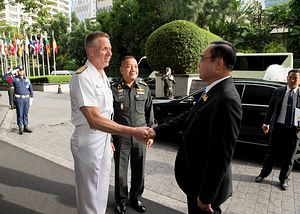Last week, the United States and other select Indo-Pacific countries held another iteration of the Indo-Pacific Chief of Defense conference in the Thai capital of Bangkok. The engagement spotlighted the evolution of the institution within the wider U.S. approach to defense policy in Asia-Pacific under the new U.S. Free and Open Indo-Pacific Strategy.
Over the years, the United States has held and supported various defense dialogues and consultations as part of its approach to the Asia-Pacific. Among these is consultations held among defense chiefs, which had initially occurred under the U.S. Pacific Command (PACOM) – subsequently renamed the U.S. Indo-Pacific Command (INDOPACOM) in May 2018 as part of Washington’s evolving approach to the region.
During the past few years, there have been efforts made to strengthen the development of what has been redesignated as the Indo-Pacific Chiefs of Defense (CHODs) conference. The general idea has been to make the Indo-Pacific CHODs conference a more high-profile, annualized forum that can showcase U.S. collaboration with allies and partners and practically strengthen military-to-military ties and advance defense collaboration on security challenges. This has occurred as the United States has advanced its own Free and Open Indo-Pacific Strategy (FOIPs) – with the Pentagon publicly issuing its own Indo-Pacific Strategy Report earlier this year – and has also been building out aspects of its defense collaboration with allies and partners including exercises.
Though it may be premature to assess the development of the Indo-Pacific CHODs conference at this stage, there are indications of the rising traction it has been getting. For instance, by one count, according to INDOPACOM, within the annualized pace that the conference has been able to sustain thus far, its size has increased from six enlisted countries in 2016 to 20 countries in 2018, even though, as with other conferences of this ilk, that list tends to ebb and flow from year to year. There has also been attention to the evolving mix of engagements at CHODs, including the balance between sessions for CHODs to engage among themselves and adding more input from invited experts in certain subject areas. The conference has also been hosted in collaboration with U.S. allies and partners as opposed to just by the United States, including the Philippines in 2016 and Canada in 2017.
The development of the CHODs conference has continued on into 2019 as well. This year’s iteration, held from August 26 to August 28, was co-hosted by both INDOPACOM and the Royal Thai Armed Forces (RTAF) in the Thai capital of Bangkok, with the involvement of one of five U.S. treaty allies in Asia attesting to Washington’s continuing desire to project it as being a collaborative dialogue rather than one being purely U.S.-centric. The holding of the conference in Thailand also placed the focus on the evolution of the defense aspect of the U.S.-Thailand alliance given the challenges it has experienced in recent years, and Southeast Asia’s role as an important part of FOIP as well with Thailand holding the ASEAN chair this year. The initial participating list also grew from 20 in 2018 to 33 in 2019.
Indications from attending country delegations at this year’s CHODs conference are that the proceedings, occurring under the banner of the theme “Collaboration in a Free and Open Indo-Pacific,” included a mix of presentations by invited guest speakers, plenary sessions for CHODs to engage in open discussions on issues, and a keynote speech, which was delivered by Thai Prime Minister Prayut Chan-o-cha. Subjects addressed included a range of current security challenges, the role of alignments, and the importance of increased communication and collaboration.
To be sure, it may be too early to make definitive assessments about the role of the Indo-Pacific CHODs conference within Asia’s security landscape given its ongoing evolution. Nonetheless, its development over the next few months and years bears watching within the context of broader trends including the development of the U.S. Free and Open Indo-Pacific Strategy, the evolution of actual shared security challenges in the region, and the mix of alignments between Indo-Pacific states more generally.

































